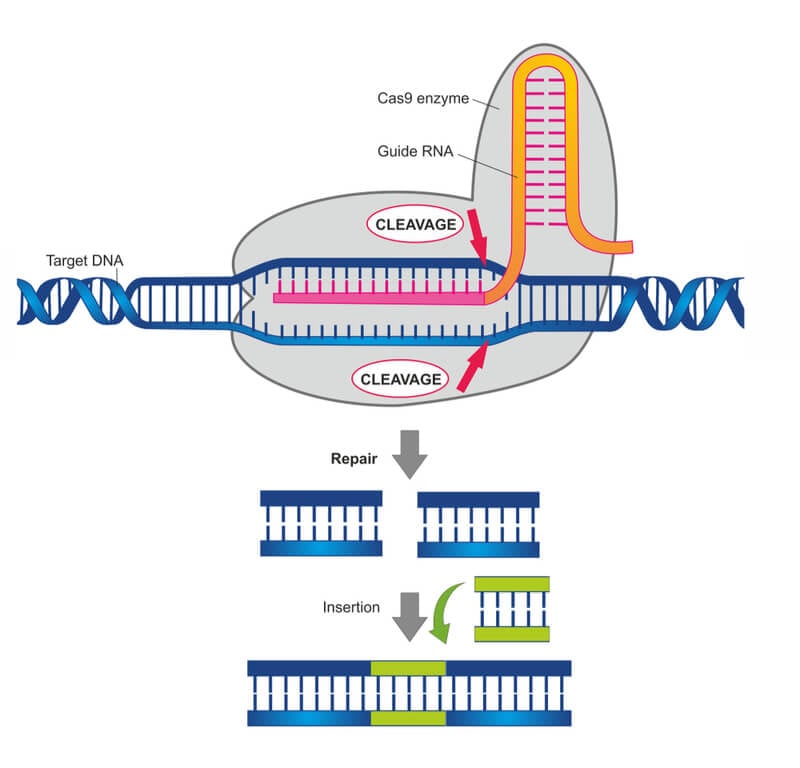Introduction:
The advent of CRISPR technology has ushered in a new era in genetic research, revolutionizing the field of gene editing with unprecedented precision and efficiency. This article delves into the multifaceted impact of CRISPR, exploring its origins, the underlying molecular mechanisms, its applications across various domains, ethical considerations, and the transformative potential it holds for reshaping the future of medicine, agriculture, and beyond.
I. Understanding CRISPR: Origins and Mechanisms
A. Origins of CRISPR-Cas9:
- CRISPR, which stands for Clustered Regularly Interspaced Short Palindromic Repeats, was first discovered in bacteria as part of their immune system to fend off viral attacks.
- In 2012, Jennifer Doudna and Emmanuelle Charpentier proposed the revolutionary use of CRISPR-Cas9 for precise gene editing in eukaryotic cells.
B. Molecular Mechanisms:
- CRISPR-Cas9 utilizes RNA molecules to guide the Cas9 protein to specific DNA sequences.
- The Cas9 protein acts as molecular scissors, making targeted cuts in the DNA, which can be repaired by the cell’s natural repair mechanisms.
II. Applications in Medicine: Healing and Beyond
A. Disease Treatment and Gene Therapy:
- CRISPR has shown immense potential for treating genetic disorders by correcting or modifying faulty genes.
- Clinical trials are underway for conditions like sickle cell anemia, beta-thalassemia, and various forms of muscular dystrophy.
B. Cancer Treatment and Immunotherapy:
- CRISPR technology enables the modification of immune cells to better recognize and target cancer cells.
- This revolutionary approach holds promise for more effective and personalized cancer therapies.
C. Infectious Disease Prevention:
- CRISPR has been explored as a tool for creating genetically modified mosquitoes resistant to carrying diseases like malaria and Zika virus.
- This approach aims to control the spread of infectious diseases by targeting the vectors responsible for transmission.
III. Agricultural Revolution: Enhancing Crops and Livestock
A. Crop Improvement:
- CRISPR enables precise modifications in plant genomes, offering potential solutions for improving crop yield, resistance to pests, and adaptability to environmental conditions.
- This technology accelerates the development of genetically modified crops with enhanced nutritional content and reduced environmental impact.
B. Livestock Modification:
- CRISPR allows for targeted modifications in the genomes of livestock for improved disease resistance, enhanced meat quality, and increased productivity.
- Ethical considerations surrounding genetically modified animals are central to ongoing discussions in agriculture.
IV. Ethical Considerations and Regulatory Challenges
A. Germline Editing and Inheritable Changes:
- The ability to edit germline cells raises ethical concerns about the potential for heritable genetic modifications.
- Global discussions are ongoing to establish ethical guidelines and regulations surrounding the use of CRISPR in human germline editing.
B. Off-Target Effects and Unintended Consequences:
- The precision of CRISPR is not absolute, and off-target effects remain a concern.
- Continuous research is focused on minimizing off-target effects to ensure the safety and accuracy of CRISPR applications.
C. Access and Equity:
- Ensuring equitable access to CRISPR technology raises questions about socio-economic disparities in benefiting from gene editing advancements.
- Striking a balance between scientific progress and responsible application remains a critical aspect of the ethical discourse surrounding CRISPR.
V. Future Perspectives: Challenges and Opportunities
A. Advancements in CRISPR Technology:
- Ongoing research is dedicated to refining CRISPR technology, addressing limitations such as off-target effects and delivery methods.
- The continuous evolution of CRISPR systems, including prime editing and base editing, holds promise for even greater precision in gene editing.
B. Therapeutic Breakthroughs:
- CRISPR-based therapies are poised to revolutionize the treatment landscape for various genetic and rare diseases.
- The potential for personalized medicine, tailored to an individual’s genetic makeup, presents an exciting frontier in healthcare.
C. Ethical and Regulatory Frameworks:
- The development of robust ethical guidelines and regulatory frameworks is imperative to ensure the responsible and equitable application of CRISPR technology.
- Ongoing dialogues involving scientists, policymakers, and the public are essential to navigate the ethical complexities of gene editing.
VI. Conclusion:
CRISPR technology represents a transformative force that is reshaping the landscape of genetic research, medicine, and agriculture. Its unparalleled precision and versatility offer unprecedented opportunities for addressing genetic disorders, enhancing agricultural practices, and pushing the boundaries of scientific discovery. However, with great power comes great responsibility, as ethical considerations and regulatory challenges underscore the need for careful and deliberate application of CRISPR. As we stand at the forefront of this genetic revolution, the impact of CRISPR technology on human health, food security, and the broader understanding of life’s intricacies is poised to shape the future in ways that were once unimaginable. The journey of CRISPR is one of immense promise, but its realization necessitates a balanced and ethical approach to harnessing the full potential of gene editing for the betterment of humanity.
